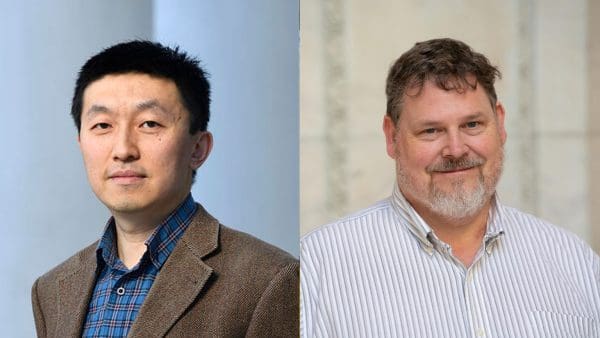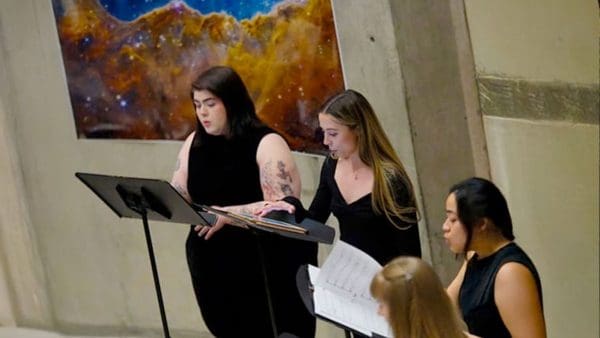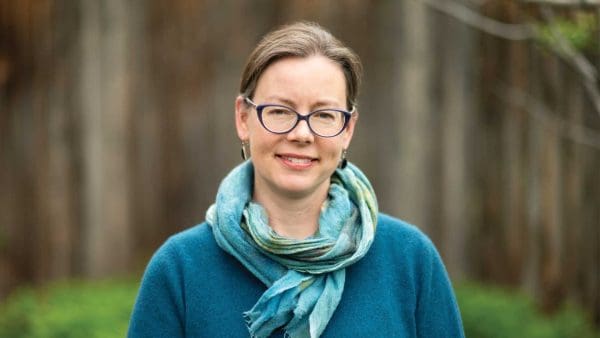The day the 29 students in this summer’s Humanities Collaboratory officially presented their research to peers, instructors, family, and other onlookers over Zoom, the supportive chats pouring in told the story. “Absolutely crushed it,” said one. “Knock it out of the park.” “That delivery though.” “Love you son!”
It’s the fourth year for the Collaboratory, the brainchild of Natalie Strobach, assistant dean for undergraduate research and director of the Office of Undergraduate Research, Scholarly and Creative Activity (URSCA). Strobach leads the program along with a postdoctoral fellow, the assistant director of URSCA, three graduate student instructors, and a peer mentor. Over 10 weeks, students from historically Black colleges and universities (HBCUs) and community colleges around the country choose a topic, research it, and create a presentation to showcase their findings.
But this is no ordinary undergrad research program. The collaboration expressed in the chats was baked in from the beginning, both inventing a new space for scholars to explore the usually solitary humanities in the kind of synergistic style often found in science labs, and also building the confidence of highly capable students who have not yet recognized themselves as worthy of tackling high-level, groundbreaking research, Strobach says.
Everything is independently designed, and that feeds a lot into the confidence of knowing, ‘wow, I designed this from the ground up; I didn’t just become good at someone else’s thing, but my own interests have value.”
—Natalie Strobach
“And that’s why the projects are so different,” says Strobach. “We have someone working on Spike Lee films and someone doing a translation of an ancient Arabic poem and just wild variety, where you’re like, how did that happen in this one program with this one set of instructors? But it’s because they directed it, and that also builds that feeling of being an expert.”
Creating Bonds Through Research
Each morning, one of the instructors leads a session on a topic related to humanities scholarship—anything from drafting a CV, to using psychoanalysis as a research frame, to doing their own research and writing “out loud” while students observe the process, warts and all. Afternoons, students work on their research in a group. Sometimes that means long periods of silence as students read on their own, sometimes it means someone describing their research and others suggesting readings or where to look for more information. Screen sharing helped everyone see what everyone else was working on. As presentation day approaches, it means practice session after practice session, until delivery is animated, timing is precise, and PowerPoint kinks are worked out.
The process “allowed the students to really bond; they were constantly exposed to what other people were thinking about and working on,” says instructor Alex Streim, a doctoral student in the English department who studies 20th century American poetry and its relationship to pedagogy.
Students entering the program often experience the self-doubt of imposter syndrome, says Samanda Robinson, also an English doctoral student who is researching the ways in which Black science fiction can be a vehicle for social justice and liberation. But she says the Collaboratory’s sense of community erases those fears as instructors share their own research processes, their missteps and rewrites. Students discover the questions they thought too trivial or basic to raise are in fact universal. They see their peers and mentors take their work seriously, and see themselves becoming experts in their subjects. By the end of the session, they have cohered into a circle of colleagues who root for one another, challenge one another, and care about one another’s research, no matter how disparate the topics.
“Now that we’re in our last week, I think it’s finally clicking that ‘wow, we do belong in these spaces, and we are more than prepared,’” Robinson says of the students. She notes that the program’s structure also allows more informal mentoring—such as when students ask her about navigating the ivory tower and finding community as a Black woman—and that the mentoring begun there is open-ended.
They know it doesn’t just stop, but that it’s an ongoing connection that we have and that we’ll always be here for them.”
—Samanda Robinson
Growing from the Collaboratory Experience
For some participants, the experience affirms or inspires once-tentative plans—transferring from a two-year to a four-year institution, for example, or applying to graduate school. The program becomes the kind of network of connections and support that students without a family legacy of higher education often lack, says Noah Thomas, a rising sophomore at Claflin University in South Carolina.
“One of the things that’s transformative about it is it lets you know that there are people within academia, people within these very prestigious spaces, who care about you as a person and as a scholar and as an aspiring academic, and I think just knowing that you have someone who has your back can give you so much confidence,” Thomas says. “If you were ambivalent about going to graduate school, if you were ambivalent about entering these spaces before, after the program, you wouldn’t be, because of the type of support that you received. It’s been transformative in that it’s definitely prepared me for graduate school. I feel like I have a firm grasp of what I would be required to do in graduate school, because this program was essentially us doing for two months what we would do for five to seven years in a PhD program.”
Thomas, an African American Studies and English major, researched how the Africana oratorical tradition evolved into a vehicle for anti-racist activism. Using Black Panther leader Fred Hampton as an example, Thomas traced the evolution of Black oratory as a means toward spiritual harmony and the wellbeing of community from the African okyeame—a trained orator—to what Thomas calls rhetor-activists like Hampton. “His role as an orator and his role as an activist were inextricably linked,” Thomas says.
Coming from an HBCU, which he describes as an uplifting experience that provides a sense of safety, Thomas says he felt much the same security within the Collaboratory. “And I think that says a lot,” he says. “Because there’s never been a time where I have felt marginalized, oppressed, or anything. I always felt as though my voice was valued and affirmed, so it’s been an amazing experience.” Next summer, Thomas will return to the program as a peer instructor.
Ideas Into Opportunities
At the beginning of the program, students use mind-mapping techniques to explore their interests and passions, and home in on a topic narrow enough to cover in 10 weeks. Other projects this summer ranged from a Derridean understanding of friendship in Antigone and Their Eyes Were Watching God and unpacking faux feminism in Bad Bunny’s collaborations, to how Muslim women counteract perceptions of gendered oppression in Islam through autobiography and an analysis of Tupac’s bildungsroman.
Rhiannon Hartman, a rising sophomore at Richland Community College in Decatur, Illinois, knew they wanted to do something related to their passion: folklore. To help refine the topic, Strobach asked them to tell her an all-encompassing story that represents folklore, and they immediately zeroed in on the changeling. (The changeling began as a pagan story about infant boys who were replaced by sickly or deformed fairies; scholars believe the story served as an explanation of disability for parents.) “The changeling is what folklore is all about. It’s a coping mechanism, and that’s what folklore is,” says Hartman, who is majoring in arts with a concentration in history.
Over the next two months, they polished that initial interest into an exploration of how and why the idea of the changeling morphed from an ill boy to a misbehaving woman, as in the 1895 murder of Bridget Cleary by her husband, who claimed that he had to kill her as she had been taken by the fairies. Meanwhile, they themself morphed from a tentative first-year with plans to teach high school history, to a confident researcher with plans to publish their changeling research and become a professor of folklore.
“This whole program has opened up so many opportunities,” Hartman says. “I never thought that I would be sitting here adding to conversations and research. I get to be a part of academia now; that’s so cool.”
I believe in myself so much more now. I have bigger goals, but now I think I can achieve them. I know that I have the ability to do great things because I’ve done great things with this program, and there’s so much more to come.”
—Rhiannon Hartman
That leap in confidence and sense of belonging is exactly what Strobach says she is aiming for. A qualitative study over the past few summers has shown that students typically arrive with rock-bottom levels of confidence, and leave with levels peaking across indicators like “I feel like I have something to offer my peers” and “I belong at a research university.”
“It’s about getting them to understand how much more they can do than they thought; it’s just about changing their expectation,” Strobach says.
How the Collaboratory Works
The Collaboratory is funded by the Andrew W. Mellon Foundation and the Leadership Alliance, a partnership between higher education, business, and the public sector that has connected more than 4,000 scholars with research, mentoring, and networking experiences. Undergrad participants and graduate instructors all receive stipends, allowing them to forego often necessary summer jobs. The Krieger School increased its own funding this year, raising the number of students from HBCUs from three in 2019 to 10 (the program was on hiatus due to the pandemic in 2020).
Strobach’s overall goal is multifold. The program has a role to play in diversifying the professoriate and the graduate school pipeline, she says, as well as exposing more students with fewer research opportunities to research and scaling up undergraduate research in general. There’s a general shortage of undergraduate research in the humanities, she points out, because faculty are often less available in the summer due to conferences and their own research commitments, and also because humanities students are typically mentored one on one, creating far fewer opportunities than exist in science labs.
Through applications and interviews, Strobach selects driven participants for whom graduate school seems to be a good eventual fit, she says. She looks for those who will work well in a collaborative setting, can handle an intense research schedule, and who want to be “agents in their own education.”
The model is unusual; instructors are experienced researchers, but they’re unlikely to be familiar with the specific research areas students choose, which creates some vulnerability for instructors, she says. But that absence of hierarchy becomes one of the ingredients that shows participants how little space there really is between them and established, successful scholars.
“Typically, you’re sitting there dumping information into a student; this receptacle model is traditionally what happens,” Strobach says. “Here, we build an expertise with them, which is putting us in a really weird, vulnerable position that they never see their educators in. That helps us as instructors to stay on our toes, but it also helps them to understand that sort of myth of expertise that they’ve always been given, as if we’re born a Shakespearean scholar or something.”
Growth for Students and Instructors
For the graduate students, the experience offers not just an opportunity to practice teaching, but a whole new perspective on how to teach and what teaching consists of. Even during last summer’s hiatus, when the instructors spent their time developing modules and implementation strategies to share the model more broadly, the program seeped into their expectations for themselves as future professors and researchers.
Robinson had always had her eye on a tenure track professorship and continues toward that goal, but she says the work last summer, in particular, gave her an additional skill set to broaden her options and made her think deeply about how to implement into any classroom the kind of lab collaboration the program embodies.
“This has definitely opened me up more into making sure I have conversations with my students and see how they’re feeling, and then thinking about how that reflects in the work that they’re producing and turning in,” Robinson says.
Graduate student Streim says his experience as an instructor in the Collaboratory has expanded his sense of the very purpose of teaching. “In previous teaching experiences, I feel like I’m sometimes bound by a list of outcomes. This was no less rigorous, but it was slightly more open-ended in terms of what those outcomes were,” he says. “Outcomes that are not just technical skills, although that was part of it, but other things like self-esteem and responsibility toward others, as researchers but also just as humans in the world. There was a wider range of what could be taught and learned, and that was exciting to me.”




